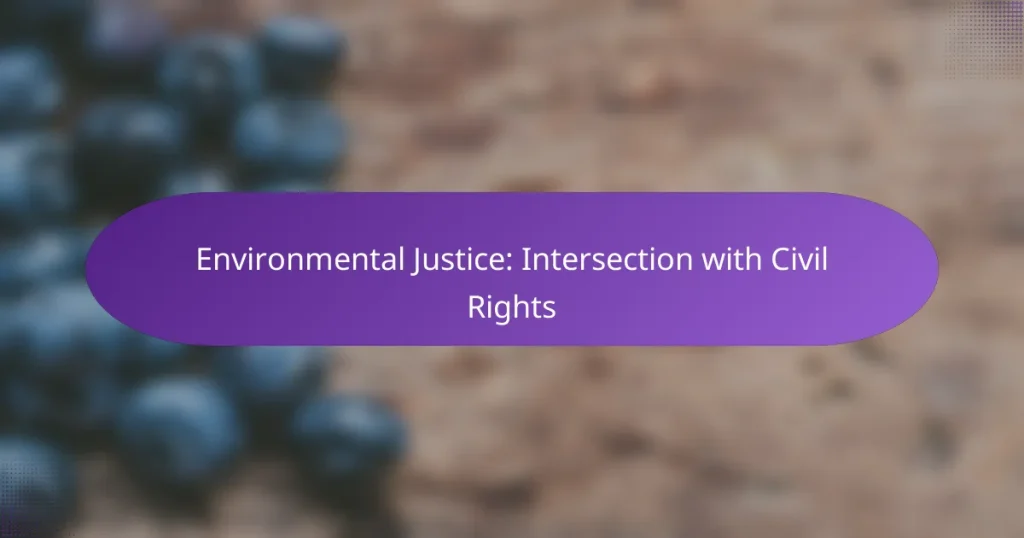Environmental justice is intrinsically linked to civil rights, focusing on the unequal impact of environmental hazards on marginalized communities. Both movements strive for equitable treatment and protection under the law, advocating for those disproportionately affected by environmental degradation and systemic inequalities.
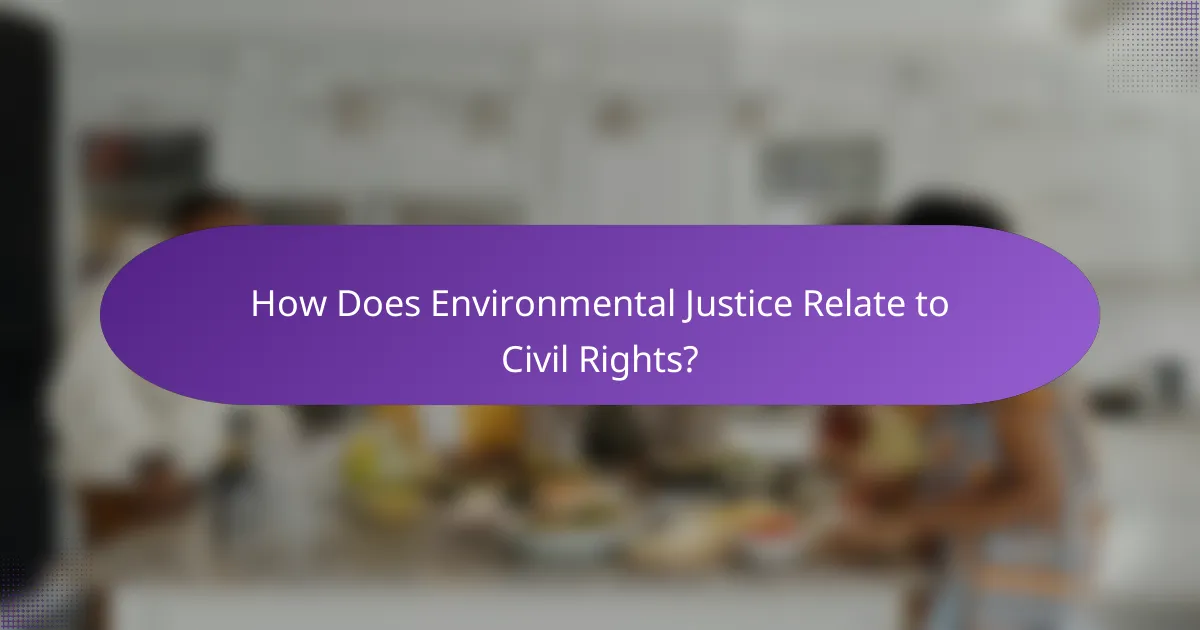
How Does Environmental Justice Relate to Civil Rights?
Environmental justice is closely linked to civil rights as it addresses the disproportionate impact of environmental hazards on marginalized communities. Both movements seek to ensure equitable treatment and protection under the law, advocating for the rights of those affected by environmental degradation and systemic inequalities.
Historical context of civil rights
The civil rights movement emerged in the mid-20th century, focusing on ending racial segregation and discrimination against African Americans. This struggle highlighted systemic injustices that extended beyond social and political realms, encompassing environmental issues such as pollution and access to clean resources.
Key events, such as the 1963 March on Washington, underscored the interconnectedness of civil rights and environmental concerns. Activists recognized that marginalized communities often faced greater exposure to environmental hazards, prompting a broader understanding of justice that included ecological factors.
Key legislation linking both movements
Several significant laws have been enacted to bridge civil rights and environmental justice. The Civil Rights Act of 1964 prohibits discrimination based on race, color, or national origin, laying the groundwork for addressing environmental inequalities. Additionally, the National Environmental Policy Act (NEPA) requires federal agencies to consider environmental impacts, which has been used to advocate for affected communities.
The establishment of the Environmental Protection Agency (EPA) in 1970 further emphasized the need for equitable environmental policies. In 1994, President Clinton’s Executive Order 12898 specifically aimed to address environmental justice in minority and low-income populations, reinforcing the link between civil rights and environmental protection.
Impact on marginalized communities
Marginalized communities often bear the brunt of environmental hazards, facing higher rates of exposure to pollutants and limited access to clean air and water. This inequity can lead to significant health disparities, including respiratory illnesses and other chronic conditions.
Efforts to promote environmental justice have empowered these communities to advocate for their rights and demand accountability from corporations and government entities. Grassroots organizations play a crucial role in raising awareness, mobilizing residents, and influencing policy changes that aim to rectify historical injustices.

What Are Effective Strategies for Promoting Environmental Justice?
Effective strategies for promoting environmental justice involve grassroots community engagement, policy reform, and collaboration with civil rights organizations. These approaches aim to address the disproportionate environmental burdens faced by marginalized communities while fostering equitable access to resources and decision-making processes.
Community organizing initiatives
Community organizing initiatives are vital for empowering local residents to advocate for their environmental rights. These initiatives often involve forming coalitions that unite diverse groups around common goals, such as reducing pollution or improving access to green spaces. Engaging community members through workshops and meetings helps build awareness and mobilizes action.
For successful organizing, consider using methods like door-to-door outreach, social media campaigns, and public demonstrations. These tactics can effectively raise awareness about specific environmental issues and galvanize community support.
Policy advocacy and reform
Policy advocacy and reform are crucial for creating systemic changes that promote environmental justice. This involves lobbying for legislation that addresses environmental inequalities, such as stricter regulations on emissions in heavily impacted areas. Advocates should focus on building relationships with policymakers to ensure that the voices of affected communities are heard.
Effective advocacy strategies include drafting policy proposals, participating in public hearings, and collaborating with legal experts to challenge unjust regulations. Engaging in these activities can lead to meaningful reforms that improve environmental conditions for vulnerable populations.
Partnerships with civil rights organizations
Forming partnerships with civil rights organizations enhances the effectiveness of environmental justice efforts. These organizations often have established networks and expertise in advocating for marginalized communities, making them valuable allies. Collaborating can amplify voices and increase the impact of initiatives aimed at addressing environmental disparities.
To foster successful partnerships, organizations should align their goals and strategies, share resources, and engage in joint campaigns. This collaboration can lead to a more comprehensive approach to tackling both environmental and civil rights issues, ultimately benefiting the communities involved.
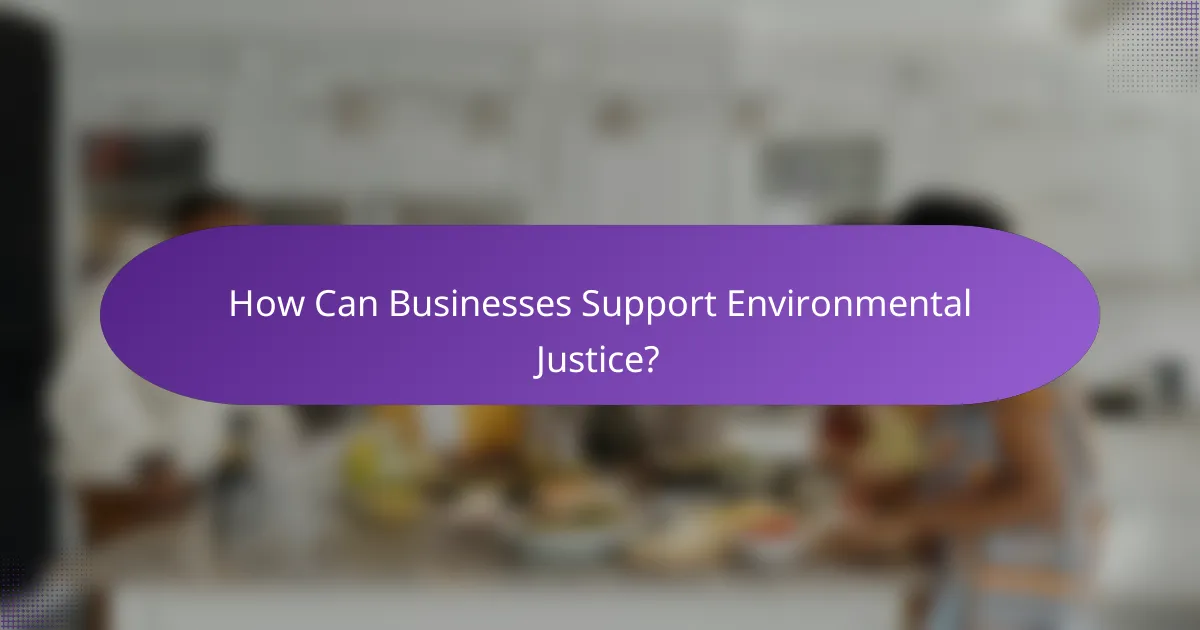
How Can Businesses Support Environmental Justice?
Businesses can support environmental justice by adopting practices that promote sustainability, engage with communities, and enhance local economies. This approach not only benefits the environment but also fosters equitable treatment for marginalized populations affected by environmental issues.
Implementing sustainable practices
To support environmental justice, businesses should implement sustainable practices that minimize their ecological footprint. This includes reducing waste, conserving energy, and utilizing renewable resources. For example, companies can adopt energy-efficient technologies or switch to biodegradable materials.
Additionally, businesses can conduct regular assessments to identify areas for improvement in their operations. Setting measurable sustainability goals can help track progress and ensure accountability.
Engaging in corporate social responsibility
Corporate social responsibility (CSR) is crucial for businesses aiming to support environmental justice. By actively participating in community initiatives, companies can address local environmental concerns and build trust with residents. This might involve sponsoring clean-up events or investing in green infrastructure projects.
Moreover, transparent communication about CSR efforts can enhance a company’s reputation and encourage other businesses to follow suit. Establishing partnerships with local organizations can amplify the impact of these initiatives.
Supporting local economies
Supporting local economies is a vital aspect of promoting environmental justice. Businesses can prioritize sourcing materials and services from local suppliers, which not only reduces transportation emissions but also strengthens community ties. This practice helps create jobs and fosters economic resilience.
Additionally, companies should consider investing in local workforce development programs. Training initiatives can empower residents with skills needed for green jobs, ensuring that the benefits of environmental sustainability are shared equitably within the community.
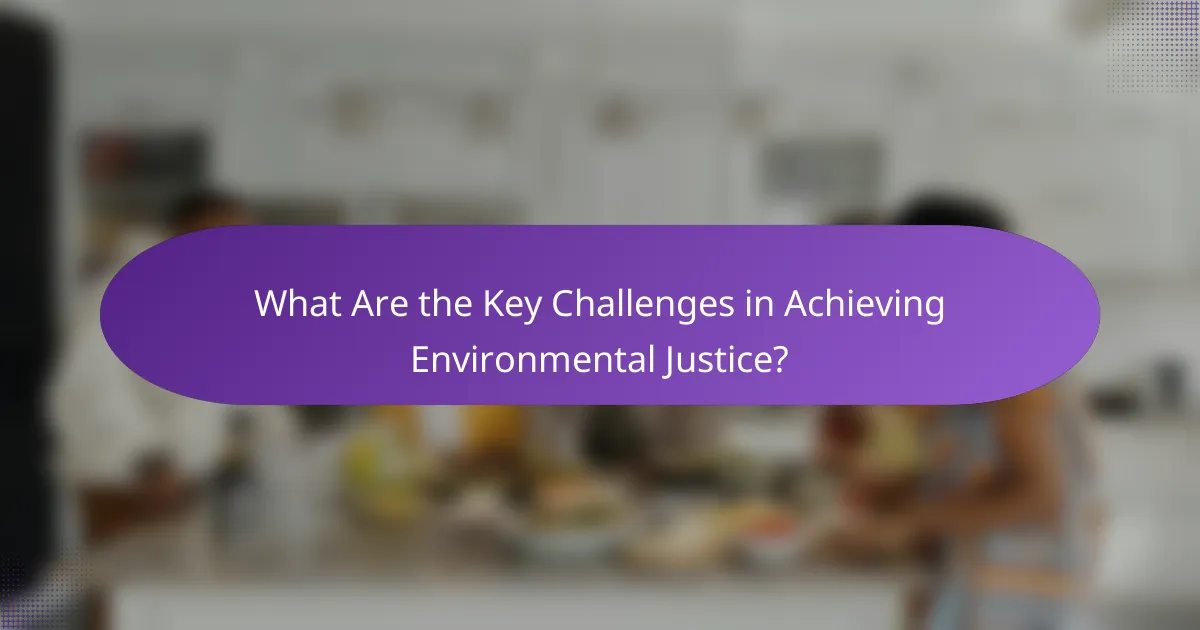
What Are the Key Challenges in Achieving Environmental Justice?
Achieving environmental justice faces several key challenges, including systemic inequalities, a lack of political will, and the effects of environmental degradation. These obstacles hinder equitable access to clean air, water, and land, disproportionately affecting marginalized communities.
Systemic inequalities
Systemic inequalities manifest in various forms, such as socioeconomic disparities, racial discrimination, and unequal access to resources. These factors contribute to a cycle where disadvantaged communities are more likely to live in polluted areas and have limited means to advocate for their rights.
For example, low-income neighborhoods often lack the infrastructure to combat environmental hazards, leading to higher rates of health issues. Addressing these inequalities requires targeted policies that empower affected communities and ensure equitable distribution of environmental benefits.
Lack of political will
A significant barrier to achieving environmental justice is the lack of political will among decision-makers. This can stem from competing interests, insufficient public awareness, or the prioritization of economic growth over environmental protection.
To overcome this challenge, grassroots movements and advocacy groups play a crucial role in raising awareness and pushing for policy changes. Engaging local communities in the political process can help ensure that their voices are heard and considered in environmental decision-making.
Environmental degradation effects
Environmental degradation has far-reaching effects, particularly on vulnerable populations. Issues such as air and water pollution, climate change, and habitat destruction disproportionately impact marginalized communities, leading to health disparities and economic challenges.
For instance, communities near industrial sites often face higher exposure to toxic substances, resulting in long-term health consequences. Addressing these effects requires comprehensive strategies that include environmental monitoring, community engagement, and robust regulatory frameworks to protect at-risk populations.
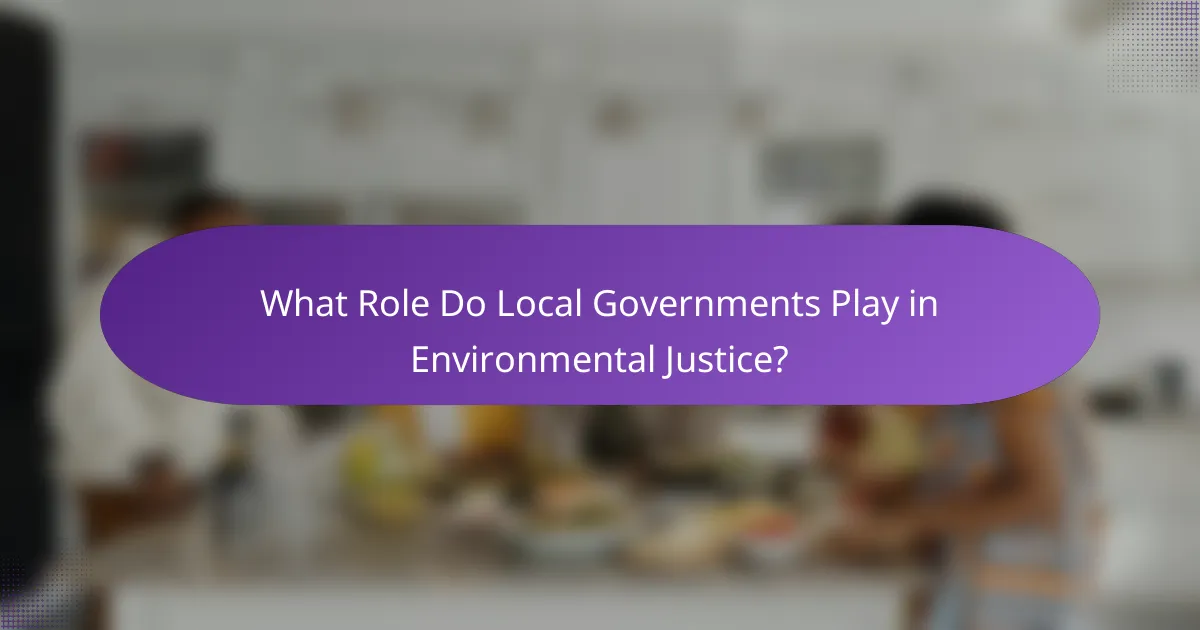
What Role Do Local Governments Play in Environmental Justice?
Local governments are crucial in advancing environmental justice by creating and enforcing policies that address environmental disparities. They have the authority to implement regulations, engage communities, and allocate funding for programs that promote equitable access to clean air, water, and safe living conditions.
Policy implementation and enforcement
Local governments are responsible for developing and enforcing policies that ensure environmental protections are equitably applied. This includes zoning laws, pollution control measures, and land-use planning that prioritize vulnerable communities. Effective enforcement requires collaboration with state and federal agencies to ensure compliance with environmental regulations.
For instance, cities may adopt stricter air quality standards that align with community health needs, particularly in areas disproportionately affected by industrial pollution. Regular assessments and updates to these policies are essential to adapt to changing environmental conditions and community feedback.
Community engagement strategies
Engaging local communities is vital for effective environmental justice initiatives. Local governments can facilitate public forums, workshops, and surveys to gather input from residents about their environmental concerns. This participatory approach helps ensure that policies reflect the needs and priorities of those most affected.
Additionally, forming partnerships with local organizations can enhance outreach efforts. For example, collaboration with environmental advocacy groups can help educate residents about their rights and available resources, fostering a sense of empowerment and community action.
Funding for environmental programs
Local governments play a key role in securing and allocating funding for environmental programs that support justice initiatives. This funding can come from various sources, including federal grants, state allocations, and local budgets. Prioritizing funding for projects that benefit marginalized communities is essential for addressing historical inequities.
Examples of funded programs might include community clean-up initiatives, green infrastructure projects, or educational campaigns on sustainable practices. Local governments should regularly assess the effectiveness of these programs and seek feedback to ensure they meet community needs and improve environmental conditions.
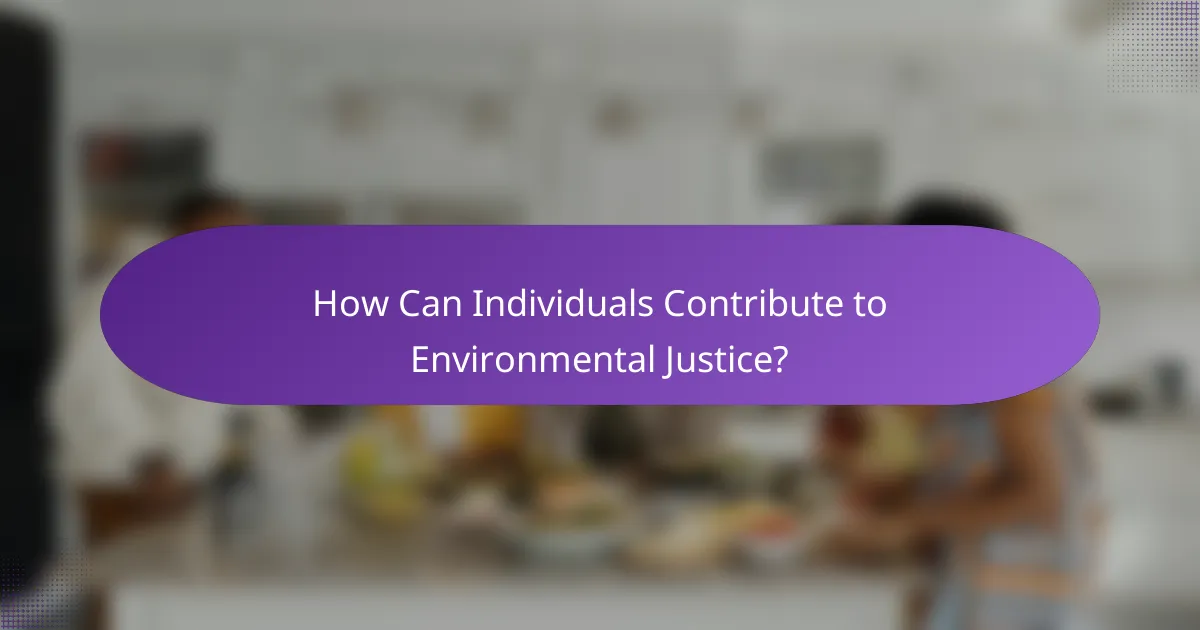
How Can Individuals Contribute to Environmental Justice?
Individuals can play a crucial role in advancing environmental justice by engaging in community efforts, advocating for policy changes, and raising awareness about environmental issues that disproportionately affect marginalized groups. Every action, no matter how small, contributes to a larger movement for equitable treatment and access to a healthy environment.
Advocacy and awareness campaigns
Advocacy and awareness campaigns are essential tools for promoting environmental justice. Individuals can participate by joining local organizations that focus on environmental issues, attending community meetings, and utilizing social media platforms to spread information about injustices faced by vulnerable populations. These campaigns often highlight the connection between environmental degradation and social inequities.
Effective campaigns often include clear messaging, compelling visuals, and calls to action that encourage community involvement. For example, organizing clean-up events in affected neighborhoods not only improves local environments but also fosters community solidarity. Engaging with local leaders and policymakers can amplify these efforts, pushing for legislative changes that support environmental equity.
To maximize impact, individuals should consider collaborating with established groups that have experience in advocacy. This can provide access to resources, training, and networks that enhance the effectiveness of their campaigns. Remember to focus on specific local issues, as these resonate more with community members and can lead to tangible change.
